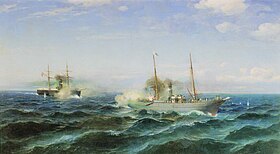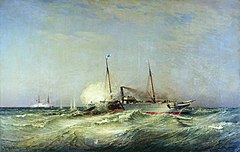Vesta (ship, 1858)
|
|
|
|---|---|
 Battle of Vesta with the Ottoman ironclad Feth-i Bülend in the Black Sea on July 11, 1877; Rufin Sudkowskyj 1881 |
|
| Overview | |
| Type | Merchant ship , auxiliary cruiser |
| Launch | 1858 |
| Whereabouts | Sunk in 1887 |
| Technical specifications | |
| displacement |
1800 t |
| speed |
12 kn |
| Armament |
5 6-inch mortar-pounder 9 2, 1 4-pounder, two small-caliber automatic weapons (Engstrema system and Gatling ), Spier torpedoes |
The Vesta ( Russian Веста ) was built in 1858 as a merchant ship. She was in operation as such for ROPiT until the beginning of the Russo-Ottoman War in 1877/78 and was then converted into an auxiliary cruiser for the Russian Navy .
Naval battle with the Feth-i Bülend
At the beginning of July 1877, the Vesta set sail in Odessa with orders to conduct combat patrols against enemy shipping in the Black Sea , but to avoid encountering larger enemy ships. On the morning of July 11th, the Vesta sighted the smoke of another ship near the port city of Kustendji, today's Constanța , and took up the chase, assuming that it was a passenger or cargo ship. At around 7:30 a.m., the first volleys of the Vesta were exchanged with the armored ship of the Ottoman Navy , the Feth-i Bülend , a much more powerful ship built in 1870 by the Thames Ironworks and Shipbuilding and Engineering Company in London. As a result, the Vesta tried to move away from the enemy ship at a speed of about 12 knots, but the Turks began an overtaking maneuver and continued to fire at the ship, causing considerable damage and deaths on the Vesta . The Vesta now shelled the Ottoman ship, which led to severe damage to one of the machine-gun turrets and a fire and caused the enemy ship to turn away. Now the Vesta took up the chase, but finally avoided the still unequal fight against the enemy ship and then safely reached Sevastopol . During the five-hour battle, three officers and nine sailors were killed and 21 injured. The surviving crew members were honored.
After the war
A memorial was erected near Sevastopol to the fallen crew members of the Vesta.
After the war, the Vesta was used again as an ordinary merchant ship until at the end of 1887, after a collision with another ship, she sank off the coast of the Crimea and killed all 34 sailors.
On March 17, 2016, specialists from the “Black Sea Underwater Research Center” announced that they had found the wreck of the Vesta at a depth of 52 m, 16 km west of Cape Tarchankut ![]() .
.
Representation in art
The battle of Vesta with the superior Ottoman ironclad was depicted in numerous paintings, some by famous painters such as Rufin Sudkowskyj , Alexei Bogoljubow and Ivan Aivazovsky .
Web links
Individual evidence
- ↑ a b c "Vesta" Secret - The story of the mysterious performance of the Russian fleet ; accessed on January 29, 2017 (Russian)
- ↑ a b Sevastopol monuments mass grave of the sailors of Vesta; accessed on January 29, 2017 (Russian)
- ↑ Description of the naval battle on Turkish war - naval sections; accessed on January 29, 2017 (Russian)

